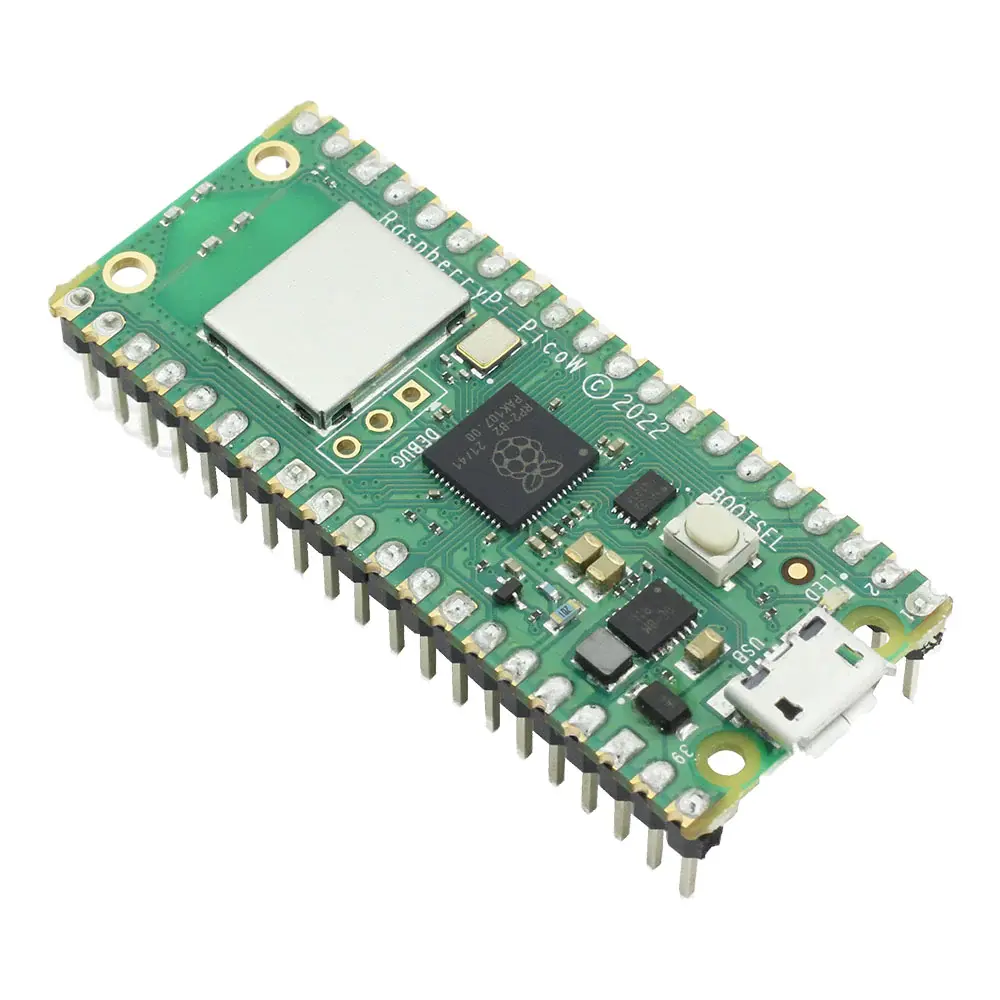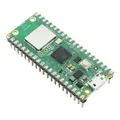Raspberry PI Pico WH - With soldered headers

Description
The Raspberry Pi Pico WH - with soldered headers builds upon the great cost-for-performance metrics of the Pico and add WiFi to the board. The Pico W features the same attributes as the Raspberry Pi Pico and also incorporates an Infineon CYW43439 wireless chip. CYW43439 supports IEEE 802.11 b/g/n wireless LAN, and Bluetooth® 5.2. (6/30/2022: Only Wireless LAN is supported on the Pico W at the moment, this will be updated as the new features become available)
Raspberry Pi Pico is Raspberry Pi's first microcontroller board, designed especially for physical computing. Microcontrollers are a different type of device than Single Board Computers (like the Raspberry Pi 4 and previous generations of Pi), they don't run an operating system and they are typically programmed to do just one task - though that task can be pretty intricate and exciting! They're perfect for experimenting with hardware and using as the brains of custom devices, machines and inventions.
It can be easily reprogrammed over USB from a Raspberry Pi or other computer using the C/C++ SDK or the official MicroPython port.
Board Specifications
- RP2040 microcontroller chip designed by Raspberry Pi in the United Kingdom
- Dual-core ARM Cortex M0+ processor, flexible clock running up to 133 MHz
- 264kB of SRAM, and 2MB of on-board Flash memory
- Castellated module allows soldering direct to carrier boards
- USB 1.1 Host and Device support
- Low-power sleep and dormant modes
- Drag & drop programming using mass storage over USB
- 26 multi-function GPIO pins
- 2×SPI, 2×I2C, 2×UART, 3×12-bit ADC, 16×controllable PWM channels
- Accurate clock and timer on-chip
- Temperature sensor
- Accelerated floating point libraries on-chip
- 8×Programmable IO (PIO) state machines for custom peripheral support
Documentation
- Raspberry Pi Pico Datasheet - An RP2040-based microcontroller board
- RP2040 Datasheet - A microcontroller by Raspberry Pi
- Hardware design with the RP2040 - Using the RP2040 microcontroller to build boards and products
- Getting Started with Raspberry Pi Pico - C/C++ development with the Pico and other RP2040-based microcontroller boards
- Pico C/C++ SDK - Libraries and tools for C/C++ development on the RP2040 microcontroller
- Pico Python SDK - A MicroPython environment for the RP2040 microcontroller
The API level Doxygen documentation for the Raspberry Pi Pico C/C++ SDK is available as a micro-site.
Properties
| Brand | Raspberry Pi |
| Model | PI-PICO-WH |
Alternative products
- In stock Raspberry Pi Pico 2 WH (with headers) € 11,- View product
- Cytron Maker Pi Pico: Simplifying Raspberry Pi Pico for Beginners € 14,90 View product
- In stock Raspberry Pi Pico 2 H € 8,80 View product
- Raspberry PI Pico - Soldered headers € 7,05 View product
- Cytron Maker Pi Pico Mini - Pre soldered pico € 15,70 View product
- Pimoroni Keybow 2040 - Tactile keys - PIM568 € 66,- View product
- In stock Raspberry PI Pico W € 8,10 View product
- Pimoroni Servo 2040 - 18 Channel Servo Controller € 22,40 View product
- Cytron Maker Pico with Pre-Soldered Raspberry Pi Pico W (Wireless) € 18,25 View product
- In stock Raspberry Pi Pico 2 W € 9,25 View product
- Pimoroni Keybow 2040 - Linear (quiet) keys - PIM561 € 66,- View product
- Kitronik Discovery Kit for Raspberry Pi Pico (Pico Included) € 20,85 View product
- Pimoroni Badger 2040 + Accessory Kit - PIM610 € 30,25 View product
- In stock Raspberry Pi Pico 2 € 7,95 View product
- In stock Pimoroni Tiny 2040 - 8MB Headered - PIM592 € 12,30 View product
- Pimoroni Plasma 2040 - PIM582 € 17,- View product
- Raspberry PI Pico € 5,60 View product
Related products
- In stock Opencircuit Micro USB cable 50 cm blue € 1,50 View product
- Cytron Maker Pi Pico: Simplifying Raspberry Pi Pico for Beginners € 14,90 View product
- Waveshare 1.8inch LCD Display Module for Raspberry Pi Pico, 65K Colors, 160×128, SPI € 11,25 View product
- Waveshare 1.3inch LCD Display Module for Raspberry Pi Pico, 65K Colors, 240×240, SPI € 10,- View product
- In stock Pimoroni LiPo SHIM for Pico - PIM557 € 8,80 View product
- In stock Opencircuit Micro USB cable 100cm blue - 30AWG € 3,20 View product
- Kitronik Discovery Kit for Raspberry Pi Pico (Pico not included) € 10,90 View product
- 5 pieces In stock Opencircuit Female header 20 pin - 2.54mm - 5 stuks € 2,60 View product
- Pimoroni Pico Breakout Garden Base - PIM549 € 18,50 View product
- Adafruit Ethernet Hub and USB Hub w/ Micro USB OTG Connector € 18,50 View product
- Kitronik Part Pack for the Raspberry Pi Pico Pathway Course € 11,35 View product
- Pimoroni Pico Audio Pack (Line-Out and Headphone Amp) - PIM544 € 18,20 View product
- Kitronik Robotics Board for Raspberry Pi Pico € 15,35 View product
- Pimoroni Enviro Weather (Pico W Aboard) - Weather Station Kitweerstation € 145,25 View product
- DFRobot IO Expansion Board for Raspberry Pi Pico € 5,10 View product
- Adafruit USB DIY Connector Shell - Type Micro-B Plug € 1,25 View product
- Pimoroni Motor SHIM for Pico € 13,- View product
- Pimoroni Pico VGA Demo Base - PIM553 € 23,90 View product
- Adafruit USB DIY Slim Connector Shell - MicroB Plug € 1,25 View product
- Adafruit USB micro B Cable with LEDs - Blue and Green € 8,75 View product
- Kitronik Simply Servos Board for Raspberry Pi Pico € 8,50 View product
- Pimoroni Pico Explorer Base - PIM550 € 23,- View product
- 2 pieces In stock Sparkfun ESP32 Thing Stackable Header Set € 3,25 View product
- Reduced In stock -1 % Waveshare SIM868 GSM/GPRS/GNSS Module for Raspberry Pi Pico, Bluetooth Connection € 39,95 € 39,75 View product
- Pimoroni Pico Breakout Garden Pack - PIM547 € 9,10 View product
- Kitronik Autonomous Robotics Platform for Pico € 41,80 View product
- Waveshare 1.3inch OLED Display Module for Raspberry Pi Pico, 64×128, SPI/I2C € 11,85 View product
- Adafruit USB Mini Hub with Power Switch - OTG Micro-USB € 7,50 View product
- Pimoroni Pico Scroll Pack - PIM545 € 16,- View product
- Cytron Robo Pico: Simplifying Robotics for Raspberry Pi Pico / Pico W € 17,15 View product
- Pimoroni Pico Proto - PIM554 € 2,40 View product
- Pimoroni Pico Unicorn Pack for Raspberry Pi Pico - PIM546 € 10,40 View product
- Reduced In stock -56 % Cytron Maker Pi Pico Mini - Simplifying Raspberry Pi Pico - without Raspberry Pi € 14,55 € 6,35 View product
- Pimoroni Pico DV Demo Base - PIM588 € 23,90 View product
- In stock Waveshare 4-digit 8-segment Display Module for Raspberry Pi Pico, SPI-compatible € 5,- View product
- Pimoroni Pico LiPo - 16MB - PIM560 € 16,30 View product
- Adafruit USB micro B Cable with LEDs - Blue and Red € 8,85 View product
- Kitronik Inventor's Kit for the Raspberry Pi Pico € 33,35 View product
- Pimoroni Pico RGB Keypad Base - PIM551 € 28,75 View product
- DFRobot Gravity: Expansion Board for Raspberry Pi Pico € 6,25 View product
- Kitronik Motor Driver Board for Raspberry Pi Pico € 9,30 View product
- Pimoroni PicoSystem - PIM559 € 69,60 View product
- Adafruit Micro B USB 2-Way Y Splitter Cable € 3,75 View product
- Pimoroni Pico Omnibus (Dual Expander) - PIM556 € 7,50 View product
- Waveshare Servo Driver Module for Raspberry Pi Pico, 16-ch Outputs, 16-bit Resolution € 13,75 View product
- Pimoroni Pico Display Pack 2.0 - PIM580 € 25,55 View product
- Adafruit Panel Mount USB Cable - B Female to Micro-B Male € 5,- View product
Customer questions
Customer Reviews
 Jonathan
JonathanSuggested products
- Opencircuit 433mhz RF transmitter + receiver € 1,75 View product
- In stock Opencircuit Male-Female 20 cm band cable 40 pieces € 1,55 View product
- In stock Opencircuit HC-SR04 Ultrasonic distance detection module € 2,15 View product
- In stock Opencircuit PIR motion detection module € 1,85 View product
- Opencircuit Breadboard white 400 points € 2,15 View product
- In stock Opencircuit Arduino Nano R3 - clone - with headers € 8,60 View product
- In stock Opencircuit RC522 RFID Reader / writer module kit 13.56MHz € 2,45 View product
- In stock Opencircuit Female-Female 20 cm band cable 40 pieces € 1,50 View product
- In stock Opencircuit Breadboard 830 points - white € 1,95 View product
- Opencircuit Gift card View product
- Raspberry Pi USB micro-B to USB-C adapter (Black) € 2,40 View product
- 5 pieces In stock Opencircuit BS170 MOSFET N-Channel - 5 pcs € 3,10 View product
- In stock Opencircuit ZVP3306A Power MOSFET, P Channel, 60V, 160mA, 14 Ohms, E Line - Through Hole € 2,70 View product
- In stock BBC micro:bit v2.21 € 17,80 View product
- Waveshare HDMI to Micro HDMI Cable, Suit for Raspberry Pi 4B € 4,50 View product
- In stock Raspberry PI Pico WH - With soldered headers € 8,10 View product
- In stock Raspberry Pi Pico 2 WH (with headers) € 11,- View product
- In stock Raspberry Pi 4 Model B - 4GB € 72,- View product
- In stock 32GB microSD with Raspberry Pi OS € 16,55 View product
- In stock Raspberry Pi Pico 2 H € 8,80 View product
- In stock Raspberry Pi 4B Official Case - black € 6,45 View product
- In stock Raspberry Pi Zero W € 21,10 View product
- In stock Raspberry Pi Official Micro-HDMI to HDMI cable (1m) € 6,75 View product
- In stock Raspberry Pi Raspberry mouse - red / white € 13,45 View product
- In stock Raspberry Pi Bumper for the Raspberry Pi 5 € 3,55 View product
- In stock Raspberry Pi Pico 2 € 7,95 View product
- In stock Raspberry Pi Keyboard (US layout) - Red / White € 26,65 View product
- In stock Raspberry Pi 4B Official Case - white € 6,45 View product
- In stock Raspberry Pi 4 Case Fan € 6,05 View product
- In stock Raspberry PI Pico W € 8,10 View product









